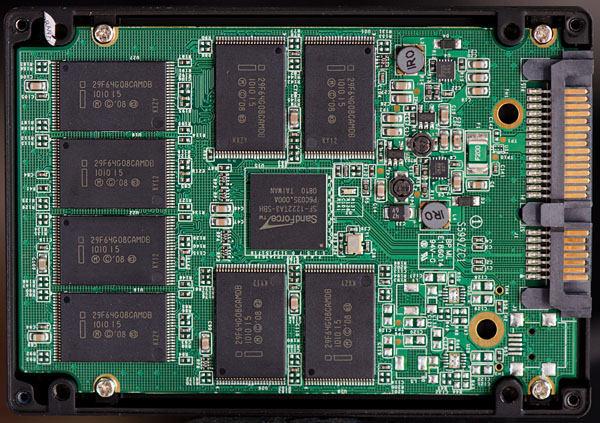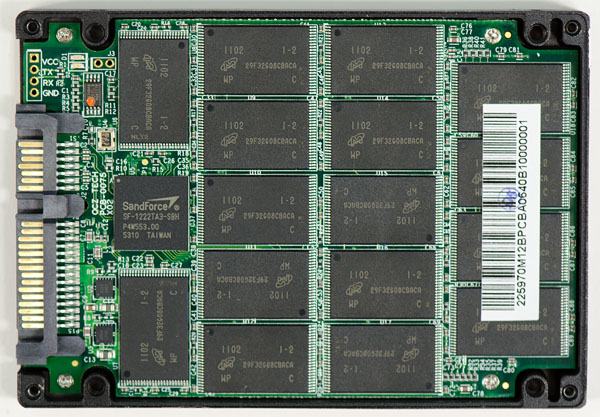The OCZ Vertex 3 Review (120GB)
by Anand Lal Shimpi on April 6, 2011 6:32 PM ESTThe Real Issue
While I was covering MWC a real issue with OCZ's SSDs erupted back home: OCZ aggressively moved to high density 25nm IMFT NAND and as a result was shipping product under the Vertex 2 name that was significantly slower than it used to be. Storage Review did a great job jumping on the issue right away.
Let's look at what caused the issue first.
When IMFT announced the move to 25nm it mentioned a doubling in NAND capacity per die. At 25nm you could now fit 64Gbit of MLC NAND (8GB) on a single die, twice what you could get at 34nm. With twice the density in the same die area, costs could come down considerably.

An IMFT 25nm 64Gbit (8GB) MLC NAND die
Remember NAND manufacturing is no different than microprocessor manufacturing. Cost savings aren't realized on day one because yields are usually higher on the older process. Newer wafers are usually more expensive as well. So although you get ~2x density improvement going to 25nm, your yields are lower and wafers are more expensive than they were at 34nm. Even Intel was only able to get a maximum of $110 decrease in price when going from the X25-M G2 to the SSD 320.
OCZ was eager to shift to 25nm. Last year SandForce was the first company to demonstrate 25nm Intel NAND on an SSD at IDF, clearly the controller support was there. As soon as it had the opportunity to, OCZ began migrating the Vertex 2 to 25nm NAND.
SSDs are a lot like GPUs, they are very wide, parallel beasts. While a GPU has a huge array of parallel cores, SSDs are made up of arrays of NAND die working in parallel. Most controllers have 8 channels they can use to talk to NAND devices in parallel, but each channel can often have multiple NAND die active at once.

A Corsair Force F120 using 34nm IMFT NAND
Double the NAND density per die and you can guess what happened next - performance went down considerably at certain capacity points. The most impacted were the smaller capacity drives, e.g. the 60GB Vertex 2. Remember the SF-1200 is only an 8-channel controller so it only needs eight devices to technically be fully populated. However within a single NAND device, multiple die can be active concurrently and in the first 25nm 60GB Vertex 2s there was only one die per NAND package. The end result was significantly reduced performance in some cases, however OCZ failed to change the speed ratings on the drives themselves.
The matter is complicated by the way SandForce's NAND redundancy works. The SF-1000 series controllers have a feature called RAISE that allows your drive to keep working even if a single NAND die fails. The controller accomplishes this redundancy by writing parity data across all NAND devices in the SSD. Should one die fail, the lost data is reconstructed from the remaining data + parity and mapped to a new location in NAND. As a result, total drive capacity is reduced by the size of a single NAND die. With twice the density per NAND die in these early 25nm drives, usable capacity was also reduced when OCZ made the switch with Vertex 2.
The end result was that you could buy a 60GB Vertex 2 with lower performance and less available space without even knowing it.

A 120GB Vertex 2 using 25nm Micron NAND
After a dose of public retribution OCZ agreed to allow end users to swap 25nm Vertex 2s for 34nm drives, they would simply have to pay the difference in cost. OCZ realized that was yet another mistake and eventually allowed the swap for free (thankfully no one was ever charged), which is what should have been done from the start. OCZ went one step further and stopped using 64Gbit NAND in the 60GB Vertex 2, although drives still exist in the channel since no recall was issued.
OCZ ultimately took care of those users who were left with a drive that was slower (and had less capacity) than they thought they were getting. But the problem was far from over.










153 Comments
View All Comments
soltys - Thursday, April 14, 2011 - link
Looking at past few articles, I was wondering - what exactly do SSDs do, that random writes are significantly faster than random reads (and looking at the tables above, 2x - 3x faster) ?Even considering magic firmware + spare space + caching - sooner or later R-E-M-W will have to be performed. And random patterns, with random data should emphasize that.
Any insights or pointers ?
Norrin - Friday, April 15, 2011 - link
Hi Anand,I have the vertex 3 installed in a 2011 macbook pro.
I'm having a horrible problem where the OS locks up for about 10 seconds every 30 minutes or so.
What was the problem that cause OCZ to delay their March 3rd launch day??
What changes were made (firmware version numbers)? How can the firmware on a vertex 3 be checked and where can the latest version be downloaded and installed?
I suspect the problem I'm seeing is the same which delayed their launch. Maybe they have a firmware update available now which can be installed in the disk I currently have....
Thanks so much!
jammmet - Tuesday, April 19, 2011 - link
I am experiencing exactly the same issue - did you find a workaround? Also, do you also have a spinning HD in your machine too?typofonic - Monday, April 18, 2011 - link
Wouldn't a Vertex 3 120 GB be a really bad choice for a boot drive when it has such a low random read performance, compared to the older Force F120/Vertex, even if I have a new SATA3 MacBook Pro?I can imagine that launching applications, booting the system etc. would be much slower with this compared to a Vertex 2/Corsair Force F120. Yes, the sequential performance is much better, but wouldn't the older drives seem snappier in normal everyday use?
Even if the Vertex 3 120GB cost the same as a Vertex 2/Force F120, wouldn't the older drives still be a much better choice for normal use, because of their high random read/write? Can't decide if I should go for the Vertex 3 or the Force F120/Vertex 2.
Anybody who knows more about this?
rgbxyz - Wednesday, April 20, 2011 - link
I own a 120 GB Vertex. I've been thinking about adding another one. However, it will not be an OCZ. With the word coming, that it seems. and I stress, seems, that OCZ can not once again be trusted. And this time around it's an even bigger issue.From the just released report: "OCZ has parlayed investor and market excitement for solid state drives (SSDs) into an amazing story. From a low of $1.79 last summer, OCZ's stock has steadily climbed more than 350% on a feel good tale told by its CEO. But there is a much darker and sinister side that has been well hidden. It is our opinion that OCZ has misrepresented its SSD growth and has financial irregularities that are nearly impossible to reconcile. We believe that some form of a restatement may be required and that the auditors tick and tie review has some substantial inconsistencies. As such, we have sent our findings to the Securities and Exchange Commission asking for clarification on the multiple sets of numbers that we have uncovered. We believe OCZ's Board has the fiduciary responsibility to form a special committee to examine these discrepancies." The bottom line for those curious where this short-seller sees the stock: "If OCZ trades in-line with the comp group, a generous assumption given OCZ's limited asset value, differentiation, and minimal profitability, a reasonable price target would be between $2.58 and $4.98 per share."
http://www.scribd.com/doc/53435574/OCZ-The-Master-...
la taupe - Friday, April 22, 2011 - link
http://www.scribd.com/doc/53435574/OCZ-The-Master-...geroj - Saturday, April 23, 2011 - link
it would be interesting to see if 2 120gb ssd-s in raid0 would be better choice over a 240gb vertex3 or intel 510 (performance and costwise).im thinking of putting 2x120gb crucial c300 in raid0, it would cost 2/3rd of a 240gb vertex3 but a thorough test would be nice before deciding.
2x64gb in raid0 is also enough for me (and as i see for a lot of us) but what about the performance?
ekerazha - Wednesday, April 27, 2011 - link
New "Vertex 3 Max IOPS" series released.120 GB
Read IOPS: 20.000 -> 35.000
Write IOPS: 60.000 -> 75.000
240 GB
Read IOPS: 40.000 -> 55.000
Write IOPS: 60.000 -> 65.000
Max Write: 520 MB/s -> 500 MB/s (decrease)
sor - Friday, April 29, 2011 - link
Yeah, what the hell is this all about? Anand mentioned in his review that there was supposed to be some sort of firmware cap on iops according to sandforce, but that his test vertex3 didn't have it, and that OCZ promised that performance of the shipping drive would be identical. Turns out apparently that they had TWO versions they were going to ship, and everyone was apparently led to believe that the test review one was the same performer that everyone has been jumping on as fast as they can ship. I think we've been duped.spensar - Saturday, April 30, 2011 - link
Love the real world benchmarks, and would like to see the Vertex 2 120gb numbers put up in the comparisions as well.